Volete imparare ad aggiungere correttamente parole chiave e meta descrizioni in WordPress?
Le meta-parole chiave e le descrizioni consentono di migliorare il posizionamento SEO (ottimizzazione dei motori di ricerca) del vostro sito web. Questo significa più traffico, contatti e vendite per la vostra azienda.
Sebbene l’aggiunta di queste parole possa sembrare tecnica, in realtà è molto semplice. Utilizziamo il plugin All in One SEO per gestire facilmente le parole chiave e le meta descrizioni sui nostri siti web.
In questo articolo vi mostreremo come aggiungere parole chiave e meta descrizioni in WordPress.
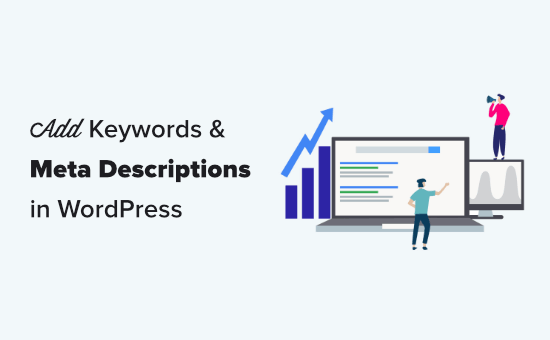
Perché aggiungere parole chiave e meta-descrizioni in WordPress?
Le parole chiave e le descrizioni consentono di fornire ai motori di ricerca maggiori informazioni sul contenuto dei post e delle pagine del vostro sito WordPress.
Le parole chiave sono parole o frasi importanti che le persone probabilmente cercheranno per trovare i vostri contenuti. La meta descrizione è una breve descrizione dell’argomento della pagina o del post.
Il titolo, la descrizione e le parole chiave vengono visualizzati nei risultati di ricerca di Google:

Le meta parole chiave e le meta descrizioni sono meta tag HTML. Fanno parte del codice dell’intestazione del vostro sito web. Non appaiono sulla pagina o sul post per essere visti dai visitatori. Tuttavia, i motori di ricerca e i browser possono utilizzarli.
Glistrumenti e i plugin SEO di WordPress consentono di aggiungerli con estrema facilità dall’area di amministrazione di WordPress per ogni post e pagina del vostro sito web.
Quanto sono importanti le meta parole chiave e le meta descrizioni per la SEO?
Come la maggior parte degli utenti di WordPress, probabilmente vi state chiedendo se l’aggiunta di meta-parole chiave e meta-descrizioni possa migliorare le classifiche SEO di WordPress.
Sebbene i motori di ricerca non condividano esattamente il peso che assegnano alle parole chiave o alle descrizioni, gli esperti SEO raccomandano sempre di aggiungere una meta descrizione e parole chiave adeguate per l’ottimizzazione SEO on-page.
Le meta-descrizioni sono ampiamente utilizzate dai motori di ricerca. Nei risultati di ricerca di Google, appaiono sotto il titolo del contenuto, con il termine di ricerca indicato in grassetto.

Una meta descrizione efficace incoraggerà gli utenti a cliccare e a leggere il contenuto del post. E sappiamo che un buon tasso di clic significa che Google probabilmente classificherà i vostri contenuti più in alto.
Quando si parla di meta-parole chiave, la maggior parte dei motori di ricerca moderni attribuisce un’importanza minima o non le utilizza affatto. La principale eccezione è rappresentata dal motore di ricerca russo Yandex.
I motori di ricerca preferiscono invece aggiungere le parole chiave mirate nel titolo, nella descrizione e in tutto il contenuto. Per questo motivo, plugin SEO come AIOSEO sono dotati di un punteggio TruSEO che aiuta a ottimizzare i contenuti per parole chiave e frasi chiave mirate.
Le nostre raccomandazioni per le meta parole chiave e le meta descrizioni
Si consiglia di aggiungere una meta descrizione per tutti i post e le pagine del sito, comprese la homepage, le pagine delle categorie e le pagine dei tag.
Nota: Google personalizza la descrizione in base alla query di ricerca, quindi utilizzerà la meta descrizione solo in parte. Vale comunque la pena di creare una meta descrizione. Apparirà in circa il 30% delle ricerche e può aiutare la SEO.
Per quanto riguarda le meta-parole chiave, sta a voi decidere se utilizzarle o meno. Non danneggeranno il vostro sito, ma potrebbero anche non essere di grande utilità.
Detto questo, vediamo come aggiungere parole chiave e meta descrizioni in WordPress. Utilizzate i link sottostanti per passare alla sezione che vi interessa:
- Installing and Activating All in One SEO for WordPress
- Enabling Meta Keyword Support in All in One SEO
- Adding Keywords and Meta Descriptions to Your WordPress Posts and Pages
- Adding Keywords and a Meta Description for Your Homepage
- Adding Keywords and Meta Descriptions to WordPress Category and Tag Archives
- Bonus: Track Your Keyword Performance with All in One SEO
Come aggiungere parole chiave e meta-descrizioni in WordPress (video tutorial)
Se preferite l’esercitazione scritta, continuate a leggere.
Installazione e attivazione di All in One SEO per WordPress
Per questo tutorial utilizzeremo All in One SEO (AIOSEO), il miglior plugin SEO per WordPress sul mercato. Permette di ottimizzare facilmente l’intero sito WordPress per una migliore SEO e viene fornito con un set completo di strumenti per far crescere il vostro business.
Per prima cosa, è necessario installare e attivare il plugin All in One SEO. Per maggiori dettagli, consultate la nostra guida su come installare un plugin di WordPress.
Dopo l’attivazione, All in One SEO vi guiderà attraverso una semplice procedura di configurazione guidata. Seguite le istruzioni passo passo per configurare il vostro sito. In alternativa, potete seguire la nostra guida su come configurare correttamente All in One SEO per WordPress.
Dopo aver completato l’impostazione, è sufficiente fare clic sul pulsante “Termina l’impostazione e vai alla dashboard”.
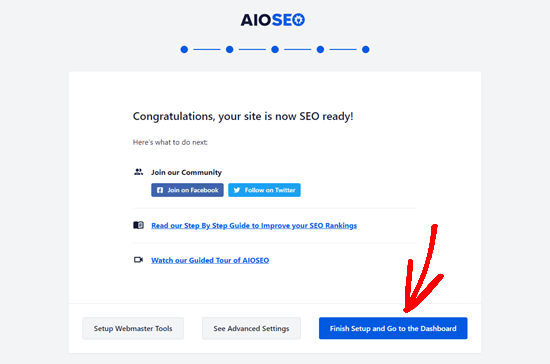
Abilitazione del supporto delle meta-parole chiave in All in One SEO
All in One SEO è dotato di un supporto integrato per le meta descrizioni e le parole chiave. Tuttavia, la funzione meta-parole chiave è disattivata per impostazione predefinita. Questo perché molti motori di ricerca danno poca o nessuna importanza alle parole chiave nelle loro classifiche.
Per abilitarlo, andate su All in One SEO ” Aspetto della ricerca ” Avanzate nella vostra dashboard di WordPress. Quindi, spostate la levetta delle meta-parole chiave da No a Sì.
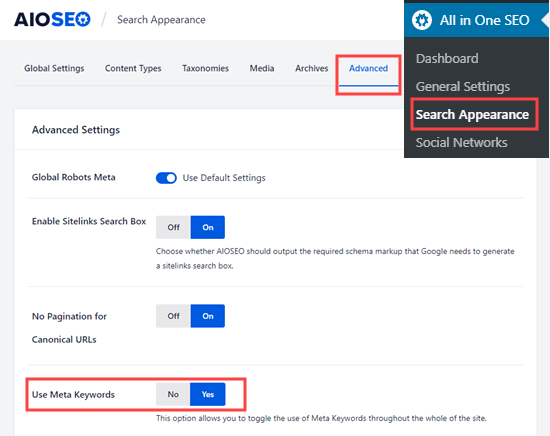
Dopo aver abilitato le meta-parole chiave in WordPress, si vedranno alcune opzioni aggiuntive.
È possibile generare le parole chiave di una pubblicazione a partire dalle sue categorie e/o tag. Inoltre, è possibile generare dinamicamente parole chiave pertinenti sulle pagine dei blog e degli archivi di WordPress.
Sta a voi decidere se utilizzare o meno queste opzioni automatiche. In ogni caso, potrete sempre definire manualmente le parole chiave per ogni post e pagina.
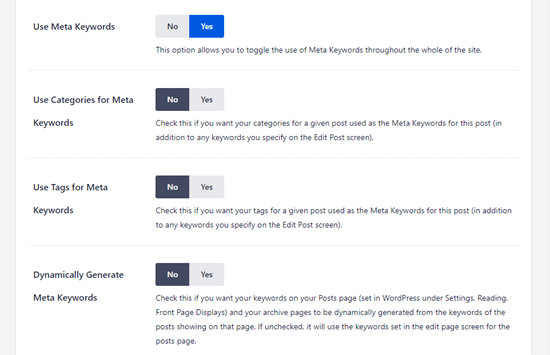
Non dimenticate di fare clic sul pulsante “Salva modifiche” in fondo alla pagina per memorizzare le impostazioni modificate.
Aggiunta di parole chiave e meta-descrizioni ai post e alle pagine di WordPress
Per prima cosa, è necessario modificare un post o una pagina in cui si desidera aggiungere le meta parole chiave e la meta descrizione. AIOSEO funziona sia nell’editor a blocchi di WordPress che nell’editor classico.
Una volta entrati nella schermata dell’editor di contenuti, scorrere fino alla casella “Impostazioni AIOSEO” sotto l’area dei contenuti.
Aggiungere una meta descrizione al post o alla pagina utilizzando AIOSEO
Verrà visualizzato il titolo SEO del sito e una descrizione generata automaticamente come snippet. Al di sotto di questo, si vedrà il campo “Meta descrizione”.
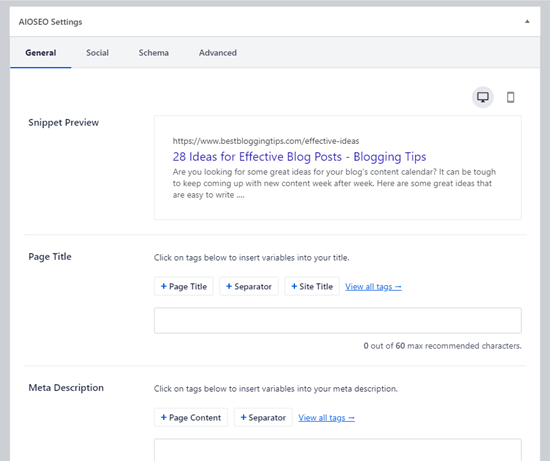
Inserite una descrizione nel campo “Meta descrizione”. All in One SEO vi farà sapere quanti caratteri avete utilizzato. Questo è importante perché Google mostrerà solo 160 caratteri nelle pagine dei risultati di ricerca (SERP).
L’anteprima dello snippet si aggiorna automaticamente man mano che si digita la meta descrizione.
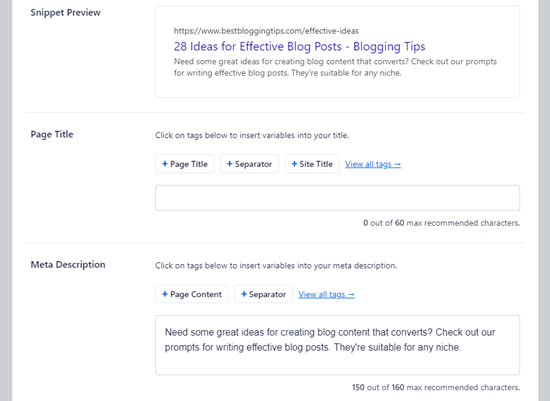
Una volta terminato, basta salvare o pubblicare il post per salvare le modifiche alla meta descrizione.
Utilizzo dei tag dinamici di All in One SEO nelle meta descrizioni
Opzionalmente, è possibile aggiungere dei tag alla meta descrizione. Quelli che All in One SEO offre di default sono Page Content e Separator, ma è possibile aggiungere anche altri tag dinamici.
Ad esempio, abbiamo aggiunto il nome dell’autore alla nostra meta descrizione.

Per aggiungere un tag, basta digitare il carattere “#” nella casella della meta descrizione.
Verrà quindi visualizzato un menu a tendina con i tag disponibili.
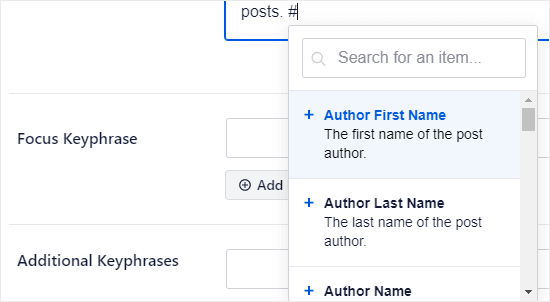
È possibile scegliere tra tag come Titolo della categoria, Anno corrente, Data del post, Titolo del post, Titolo del sito, Estratto del post e altro ancora.
Utilizzo dell’integrazione ChatGPT di All in One SEO per generare automaticamente le meta-descrizioni
Se volete risparmiare tempo, potete anche utilizzare il generatore di titoli e descrizioni di All in One SEO, dotato di intelligenza artificiale. Utilizza ChatGPT per creare automaticamente meta descrizioni di alta qualità basate sul tema principale del vostro contenuto.
Per iniziare, è sufficiente fare clic sull’icona del robot nel campo “Meta descrizione”.

Se non avete mai utilizzato questa funzione, vi verrà richiesto di creare un account OpenAI.
Inserite il vostro indirizzo e-mail e seguite i semplici passaggi della procedura guidata per creare il vostro account e collegarlo a All in One SEO.

Una volta terminato, è possibile fare nuovamente clic sull’icona del robot.
Questo genererà 5 suggerimenti di meta descrizione.
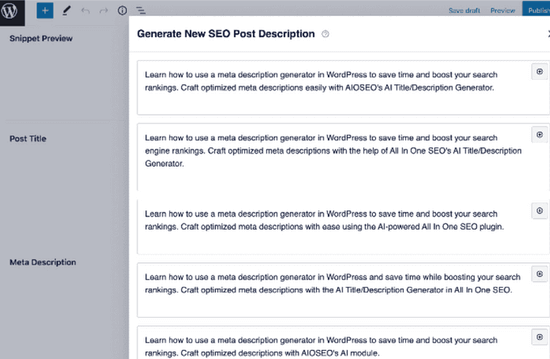
È possibile selezionare la meta descrizione desiderata facendo clic sul pulsante “+”. In seguito, verrà aggiunta automaticamente al campo della meta descrizione, dove potrete modificarla in base alle vostre esigenze.
Aggiunta di meta-parole chiave ai post o alle pagine con AIOSEO
Per aggiungere le meta-parole chiave, è necessario fare clic sulla scheda “Avanzate” delle impostazioni di AIOSEO.
È sufficiente digitare le parole chiave e premere “Invio” dopo ciascuna di esse. È importante utilizzare solo parole chiave pertinenti al contenuto. L’aggiunta di parole chiave irrilevanti non vi darà alcun beneficio in termini di SEO.
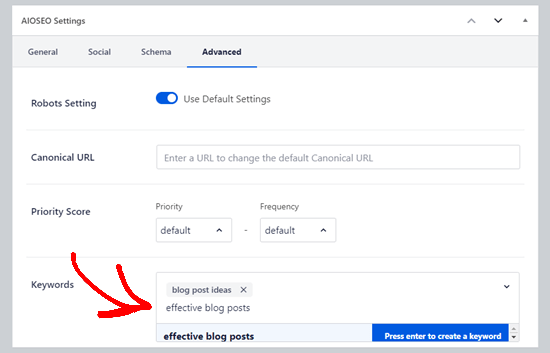
Suggerimento: le meta-parole chiave sono completamente separate dalla parola chiave principale. È possibile impostare una parola chiave prioritaria nella scheda Generale, in modo da ricevere consigli per migliorare i propri contenuti. La parola chiave principale non diventa automaticamente una meta-parola chiave per il post o la pagina.
Aggiunta di parole chiave e di una meta descrizione per la vostra homepage
Potete anche aggiungere meta-parole chiave e meta-descrizione per la homepage del vostro sito web in WordPress. Ecco come fare utilizzando All in One SEO.
Per prima cosa, andate a cercare Aspetto ” Impostazioni globali nell’amministrazione di WordPress. Quindi, scorrere verso il basso fino alla sezione Home Page.
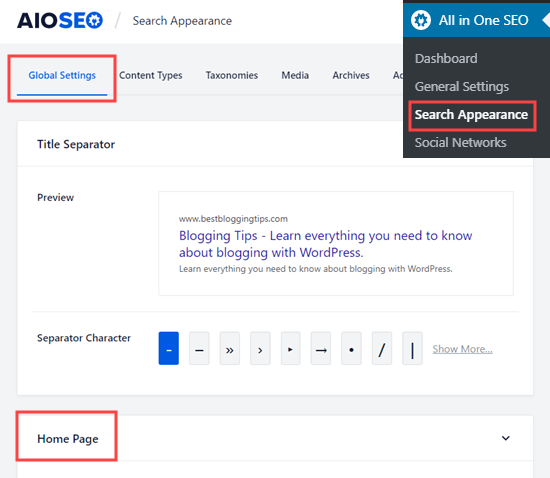
In questa schermata è possibile inserire facilmente una meta descrizione e delle parole chiave, proprio come per un post o una pagina.
Per impostazione predefinita, All in One SEO utilizza la tagline come meta descrizione. Potete lasciarla lì o personalizzarla.
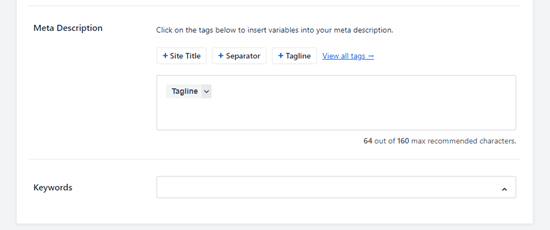
È inoltre possibile fare clic sulle altre opzioni per aggiungere tali tag alla meta descrizione. In alternativa, è possibile aggiungere tag diversi digitando il carattere ‘#’ nella meta descrizione, come descritto sopra.
Suggerimento: è meglio utilizzare questi tag piuttosto che digitare manualmente il titolo del sito, la tagline o il carattere separatore. Questo perché la meta descrizione verrà aggiornata automaticamente se in seguito si apporteranno modifiche a uno di questi tag.
Assicuratevi di fare clic sul pulsante “Salva modifiche” in fondo alla pagina dopo aver aggiunto la meta descrizione e le parole chiave.
Aggiunta di parole chiave e meta-descrizioni agli archivi di categorie e tag di WordPress
È inoltre possibile aggiungere parole chiave e descrizioni alle pagine dell’archivio delle categorie e dei tag.
Per prima cosa, è necessario visitare la pagina Messaggi ” Categorie. Posizionarsi con il mouse sulla categoria che si desidera modificare e cliccare sul link “Modifica”.
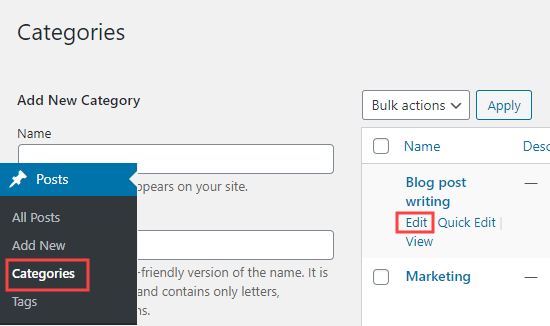
Successivamente, si deve scorrere la pagina della categoria fino alla casella Impostazioni AIOSEO.
Qui è sufficiente inserire una meta descrizione per la categoria. Anche in questo caso, è possibile utilizzare i tag di All in One SEO.
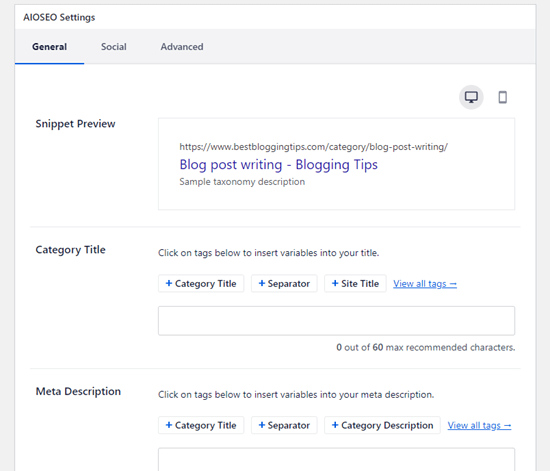
Per aggiungere le parole chiave, basta fare clic sulla scheda “Avanzate” come per qualsiasi post o pagina.
Assicuratevi di salvare le modifiche alla categoria prima di andare avanti.
La meta descrizione e le parole chiave saranno ora utilizzate per la pagina della categoria, che è l’archivio dei post di quella categoria.
È possibile ripetere la procedura per aggiungere meta-parole chiave e descrizioni ai tag del blog e alle altre pagine dell’archivio tassonomico personalizzato.
All in One SEO si integra perfettamente con altri popolari plugin di WordPress. Ciò consente di aggiungere parole chiave e meta-descrizioni per le pagine dei prodotti WooCommerce, le pagine di destinazione SeedProd, le pagine dei corsi MemberPress e altro ancora.
Bonus: monitorare le prestazioni delle parole chiave con All in One SEO
Volete sapere quanto sono efficaci le vostre parole chiave? All in One SEO non solo vi permette di aggiungere parole chiave in WordPress, ma vi aiuta anche a monitorare le loro prestazioni.
Con le statistiche di ricerca e la funzione Keyword Rank Tracker di All in One SEO, potete facilmente vedere come le parole chiave da voi scelte si posizionano nei risultati della ricerca, direttamente dalla dashboard di WordPress.
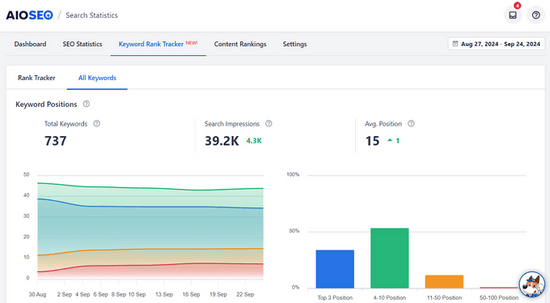
Questo include informazioni preziose come la posizione delle parole chiave, i clic, il tasso medio di clic, le impressioni, lo storico delle posizioni e molto altro ancora.
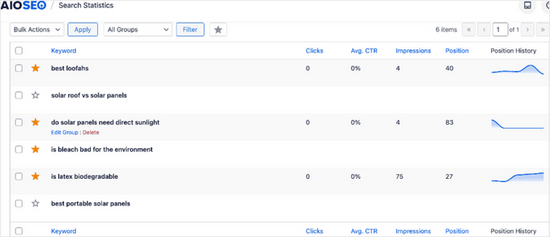
Tracciando queste metriche, potete vedere cosa sta funzionando e cosa no. Questo vi aiuterà a modificare la vostra strategia di parole chiave in modo da migliorare le vostre classifiche e portare più traffico al vostro sito.
Per maggiori dettagli, consultate la nostra guida su come verificare se i post del vostro blog si posizionano per le parole chiave giuste.
Guide di esperti sui meta-dati di WordPress
Ora che sapete come aggiungere parole chiave e meta-descrizioni, potreste voler vedere altre guide relative all’aggiunta di meta-dati in WordPress:
- Come visualizzare i meta dati delle pubblicazioni del blog nei temi di WordPress
- Come personalizzare i riassunti di WordPress (non è necessario alcun codice)
- Come aggiungere meta box personalizzati nei post e nei tipi di contenuto di WordPress
- Come aggiungere campi meta personalizzati a tassonomie personalizzate in WordPress
- Come aggiungere i meta dati dell’Open Graph di Facebook nei temi di WordPress
- Cos’è il rel=”noopener” in WordPress? (Spiegato)
- Come nascondere una pagina di WordPress da Google
Speriamo che questo articolo vi abbia aiutato a capire come aggiungere facilmente parole chiave e meta-descrizioni ai vostri post e pagine di WordPress. Potreste anche voler consultare la nostra guida su come creare una newsletter via e-mail o le nostre scelte degli esperti sui migliori plugin per i moduli di contatto di WordPress.
Se questo articolo vi è piaciuto, iscrivetevi al nostro canale YouTube per le esercitazioni video su WordPress. Potete trovarci anche su Twitter e Facebook.





Syed Balkhi
Hey WPBeginner readers,
Did you know you can win exciting prizes by commenting on WPBeginner?
Every month, our top blog commenters will win HUGE rewards, including premium WordPress plugin licenses and cash prizes.
You can get more details about the contest from here.
Start sharing your thoughts below to stand a chance to win!
Ashok Punetha
Titles & Metas not showing under the SEO
WPBeginner Support
With the recent updates with Yoast, you would want to click the snippet preview in your post editor to bring the edit options up.
Admin
Kaushik Bhatnagar
Sie,
Ita s very good knowledgeable article. I was actually searching for “Adding Keywords and Meta Description for Homepage”
There are infinite articles but failed to exhibit in pictorial form. Here it made me to understand very easily.
A million dollar thanks to you.
Mike Davis
This doesn’t work anymore. The very clever folks at Yoast disabled the keyword feature as of v 7.2
Personally, I think this is a function that does have value. Even if the search engines don’t use it, a couple rank tracking proggies I use do, but whatevs.
I rolled back to the earlier version.
I won’t ever buy Yoast SEO Premium. Too many updates, and the recent updates require too much babysitting.
James Emmanuel
You are very right. Please can you share on how to roll back to previous version? I like to do same on our website.
Chris
Can you use Wordpress Custom Fields and make them into SEO containers? The descriptions on pages and the keywords for those are important to Google because Google creates scores on your ads based on whether or not the keywords in your ads match the keywords on the landing page. I would think instead of using an SEO plugin we could just easily create custom fields and produce the same thing on a page by page and site by site basis including categories and tags – no?
Powell Nwoke
My snippet is not displaying my post contents as usual, rather its showing, “Please provide a meta description by editing the snippet below.” How do I rectify it? Thank you
Paul Gleave
The meta keywords feature has been removed from Yoast (in April 2018), for anyone looking for it now. This is because the meta keywords tag is no longer used by search engines.
Luke Harper
Thanks! What’s important for SEO now then?
Lisa Michels
I am really trying to follow the instructions but the version of Yoast SEO that I downloaded only has three tabs. Dashboard/Features/Webmaster
I watched the video and read the instructions multiple times. Please help!
Raj
Are you able to see ‘Search Appearance’ link below SEO and that will lead to some of the tabs mentioned in the article. Looks like article is bit old, but we can look for similar tabs/links in the SEO section of the WP area
Dheeraj
Great Article !
Please also post article related to news website.
Like How to create hindi news website? & How to do SEO of any news website?
Thanks
Abhishek Verma
Hello WPBeginner,
There is no option available for Title & Meta’s for Homepage in latest update of Yoast Plugin.
Please guide me.
Thanks.
Aman
Hi,
Yoast Plugin is not showing Meta keyword template in Titles & Meta -> Homepage.
Now, How can I add Meta Keywords In my website?
Rohan singh
Hi,
Yoast Plugin is not showing Meta keyword template in Titles & Meta -> Homepage.
Now, How can I add Meta Keywords In my website?
Maikaal Hydr
Simply Outstanding…..I was kinda looking such tutorial from long time, at last i got it from YOU ./….Thanx Buddy
Dolan Yok
Can you give me an answer, how best to avoid duplicate content, from images, tags, and desktops page 2 and so on
Deepak Yadav
Thanks for writing this helpful articles it helps me too much.
Riyaz
What is better? Using Meta tags, or using Yoast plug in. Also, can I know if Wordpress is HTML, HTML5 or XHTML..
Help is much appreciated.
Bradley B
Nailed it! Thank you.
Iqbal Hussain
How to add
using yoast seo plugin. I have installed yoast seo plugin in my blog but it don’d have this feature.
Iqbal Hussain
meta name revised
Kerry
Curious why you recommend using Meta Keywords? Even Yoast – as used in your example, says keywords are dead. (Thus why they advise you not bother, right on the page where you enable them?
WPBeginner Support
Hi Kerry,
Many SEO experts believe that meta keywords are not useful anymore. We do not agree with this. We think that they can still be useful and are perfectly harmless if used in moderation (i.e. avoid keyword stuffing or using too many meta keywords in each article).
Admin
amolkarde
in SEO only one focus keyword use and in premium version how many keyword use…Thanks for the meta keyword info.
Ayo
Thanks for the post. I tried to set up my homepage description on yoast. The tabs there is unclickable. I tried to click on it several times but isn’t clickable.
Mark Abahi
Thank very much I love it
febrifahmi
Hi, Sir! Thank you for the brief and easy to follow step by step explanation on adding keywords to WordPress. It’s really helpful for me as a beginner. By the way, i already used Yoast SEO plugin for my site. But i still have a question about how can we know what is working and what is not in our SEO setting, or how we measure the performance of our SEO setting from outside? Thanks!
WPBeginner Support
Hey febrifahmi,
The simplest way to measure the success of your SEO score to see if your site has started ranking for the keywords you are targeting. If those keywords have more competition, then initially you may not appear on the first or even the second page of the search results. However, overtime your ranking will keep improving if you keep following your SEO plan.
Admin
Mozammel
how can I add my research keyword of my website??
Digember
You can also use google keyword planner for keyword research.
Mike Hamme
Found exactly what i was looking for by reading this post, and you made it extremly simple to follow..so thank you!
ashima
meta keyword option is not displaying
s.k.mukherjee
Can I used more than one keywords in my wordpress blog in yoast plugins without a premium version ?
ghalia
hey
I’m having a problem that the meta description added is not shown in the page source code or on search engines.
can any one help me ?
Adi
Meta keywords not displaying … Anyone?
ranjith
In advanced setting page of yoast seo snippchet . meta keyword is not showing..
[After that you need to click on the ‘Settings’ button to enter meta keywords to be used for that particular category’s archive pages.]
Dana
do you know how long does it take for Google to update their meta description snippet after you’ve updated it in wordpress?
Nisa
Is there any function to force enable index in search page?
Kristi M Ambrose
I keep having the same issue that has been happening to me is still happening. I contacted Yoast and they could care less about my issue as a free member. If the plugin didn’t work, fine, I could get them not helping me. But the fact that this is my problem and they wont help me is utterly annoying:
I have Yoast on two different sites.
On site #1 I see one interface
On site #2 I see a completely different interface.
On site 1 I see what you see above with a whole slew of other options.
On site 2 I see a very limited view in terms of the interface and options.
WPBeginner Support
Hi Kristi,
By default, when you install Yoast SEO plugin, it hides advanced settings pages. You need to visit SEO > Dashboard and then click on the Features tab. Scroll down to ‘Advanced settings pages’ option and click on Enabled. Don’t forget to click on the save changes button.
Admin
Katie
As a new blogger, let me tell you how difficult it was to get meta data added to my blog – all in the name of getting rich pins! This was legitimately the best step-by-step instruction I’ve found (after HOURS of hunting). Thanks for the great post!
sudhakar
new to wordpress i know basic wordpress how to use themes and plugins and my doubt is what to learn next either loops and hooks and functions or php deeply because i dont know how to modify the template in theme editor what to do please help me
Rupam Chakma Babu
Nice info,very easy to understand Meta Information.
Thanks a lot.
Paul Davis
Nice. This was easy to follow, now I get to see if meta information really helps with search engines.
Asumpta
This was super helpful to me.
Deepak Patel
Detailed & Infromative, You saved my life. I was desperate to where I should insert meta Description and Keyword for my homepage.
Thank You
Aiswarya
Thank you so much sir,this article is very much useful for beginners like me.
nikhil
everything is working like charm just have an issue is that I want to put meta description for homepage and I put it over homepage section but not showing any metatag in the facebook posts meta checker while other page’s meta is showing there as desired.
please help me with index page’s metas
nikhil
Thanks admin It’s very useful for me, its just take few seconds to add meta tags and keywords using this demo examples and its pretty easier so that don’t need to be a SEO expert to do that.
Rahul
thanx admin. it is really helpful for me.
Bill Marshall
This is utter rubbish! No SEO expert thinks meta-keywords are of any use at all – only people who have read other inaccurate and outdated posts like this one. Google stopped using them about 15 years ago, Bing only use them to identify spammers.
Ja Ochui
If you had actually read the article, you will realise that the author wrote exactly that: “Even Google says that they don’t give importance to meta keywords.”
Manjunath
Hello, thanks for letting know about the meta keywords and I found this post very useful. I never used meta keywords but after reading this post and letting the importance of the meta keywords I feel I should use these keywords on my blog.
Kufre Akpan
This post is really good. It makes me battle ready for my competitors. Thanks admin!
Attila
Hi,
How should we proceed with the custom meta descriptions for categories (custom taxonomy) with several sub pages (for ex: category: apple tv 4. page 1, page 2, page 3) as google see it as duplicate meta description for each sub page.
Your “Meta Keywords and Description for Category Archives” description is ok if I have 1 single page in that particular category. But what about if I have more then one?
Yoast have a great solution for the titles in this case (for ex: Title: Apple TV 4 – site name – page 2 of 3) but not for the “CUSTOM” meta descriptions for the categories with sub pages.
Our case ex:
Articole page – with 4 categories
Cat 1. Apple tv 1 result: 6 sub pages
(for the titles we use Yoast/Titles/Taxonomy
Title: %%term_title%% %%sitename%% %%page%%
= Apple tv 1 – site name – page 1 of 6) The result is OK!
(for the custom meta description we are using: Categories/Edit)
and the meta description is the same on each page!!) This is the problem:) How can we fix this?
Any ideas please:)
Thanks
Gerardo Morillo
Hey,
Thanks for creating this post I found it very helpful. I had no idea Yoast disabled this by default. I used to think this was unimportant. I will test now and see if it helps me increase my traffic.
Thanks,
Gerardo
Eka
I’ve ever use Yoast before, but doesnt give any change on my snippet, then manually I add my meta tag on head every single post and it works, but another problem is my post give a distance between content wich is paragraph and Post title, well I don’t know why because I’m not use a visual mode to edit my post..any advice maybe? need guide please…and sorry for my english…thank you
Steve Williams
Thanks for the meta keyword info. It shouldn’t hurt if I implement them.
BTW, how did you implement your sidebar “I need help with …” widget? Is it done via a special plugin?
Off to share your post.
-steve
WPBeginner Support
Hi Steve,
Yes it has custom CSS and some custom code behind it.
Admin
Joanne Taylor
Sincerely Thank You! This article was very informative for a true beginner as myself. Do you have a live YouTube on step -by-step blogging for beginners?
WPBeginner Support
Hi Joanne,
Check out our YouTube Channel. It has tons of video tutorials covering many different topics about using WordPress.
Admin
Priyanshu Raj
Meta keyword are good for SEO ?
And what is this ?
If you type something above it will override your meta keywords template.
WPBeginner Support
Hi Priyanshu,
Some experts believe that they are redundant now, but many other SEO experts disagree. We believe that they are still useful.
If you turn on Meta Keywords, then Yoast SEO will try to get your keywords from your post’s tags. However, if you enter them manually, then it will not use tags as keywords.
Admin